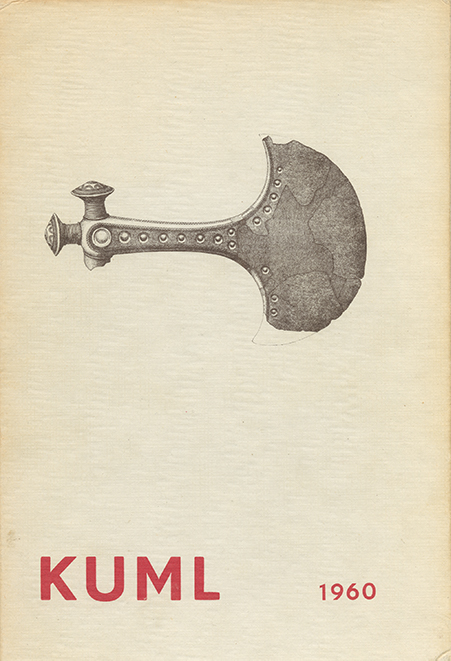Årupgårdfundet
DOI:
https://doi.org/10.7146/kuml.v10i10.103104Keywords:
Årupgård, Hoard, amber beads, ravperler, early neolithic, tidlig neolitisk, finger ring, fingerring, kobber spiral ring, Copper spiral ring, kobber cylinder, copper cylinder, Zwickau, depot, offerAbstract
The Årupgård Hoard
In October 1958, in the course of gravel digging at Årupgård near Horsens in Jutland, the pieces of a pottery vessel containing amber beads and copper ornaments were found. The potsherds could be reconstructed, to form an undecorated lugged vase with 5 lugs placed low on the body (Fig. 2). Similar lugged vases are known in Denmark, from settlement sites and peat-bog deposits, but they vary greatly in size, ornamentation and number of lugs 1)-12). Apart from a single lugged vase from Rügen 13) no similar vases are known outside Denmark. The Årupgård vase must have been produced by non-megalithic funnelbeaker people of Jutland in Early Neolithic Period C or in the beginning of the Middle Neolithic 18) 19).
The amber in the hoard consists of 271 beads and 177 fragments. They can be divided into unformed lumps with the appearance of natural amber, and cylindrical and conical beads where the amber has been shaped to these forms. Their appearance is shown in Table 1 and Figs. 3-6. All types of beads here represented are known from Early Neolithic times in Denmark 21). To judge by the marks of wear the beads have formed parts of necklaces. 57 amber hoards from this prehistoric period are known on Danish soil, containing greatly varying numbers of beads 23).
The copper objects comprise 2 spiral finger-rings, 2 long spiral cylinders, 3 small spiral cylinders and one cylinder of copper sheeting (Fig. 7). In the latter was found pollen susceptible to analysis (p. 17). With its large proportion of Plantago lanceolata this pollen shows that the wearer of the copper ornament spent his (or her) time mainly in a landscape of common-land type.
While the pottery vessel and the amber beads must have been produced in Denmark the copper ornaments must have been imported. Of objects of copper about fifty axes are known from unassociated finds on Danish soil 38). At Bygholm, only 4 kms. from Årupgård, the wellknown Bygholm hoard was discovered in 1924 (Fig. 8). At Søby Heath a copper axe and a spiral ribbon of the same metal have been excavated 40), from the Barkær settlement some small fragments of copper sheeting are known 41), and in a grave at Salten the remains of a disc-shaped copper ornament were found 42). The Salten ornament, the Barkær copper and the Årupgård ornaments belong to the non-megalitihic Period C (or perhaps D), and the Bygholm board must be attributed to the Late Dolmen Period 45) or the beginning of the Passage-Grave Period 46), and is thus contemporary with or later than the Årupgård hoard.
Copper spiral rings and cylinders of the Årupgård type have been found at many points in Europe, and from the Early Neolithic Period they are particularly known from the Alpine and Danube cultures 48). Spiral rings of copper do not appear to occur within the area of the Southwest European cultures 51). During the following periods spiral rings and cylinders spread over Europe, first in copper and later in bronze, and occur commonly throughout the Bronze Age 52). At Riesebusch, Skarbnice and Stollhof copper hoards have been found which link the Årupgård and Bygholm hoards together typologically. Spectroscopic analysis (Table 2) shows that the copper from Årupgård, Bygholm and Riesebusch originally came from the copper mines at Zwickau, as a similar copper ore with arsenic content can be found there 58). The Årupgård ornaments may have been made at many different places in Europe, though probably within the Alpine or Danube cultures. In this connection attention is particularly paid to the Theiss variants in Saxony, Thuringia, Silecia, Bohemia, Moravia, Poland and Hungary 61). The copper objects must have been conveyed by river routes to the Baltic, and then along the coast to Horsens Fjord 68) 69). They may there have been traded for amber and flint 70) 71). The hoard may have belonged either to a man or a woman 76), and can be either a concealed depot or a votive offering.
Bent Sylvest and Inger Sylvest.
Downloads
Published
How to Cite
Issue
Section
License
Fra og med årgang 2022 er artikler udgivet i Kuml med en licens fra Creative Commons (CC BY-NC-SA 4.0).
Alle tidligere årgange af tidsskriftet er ikke udgivet med en licens fra Creative Commons.


